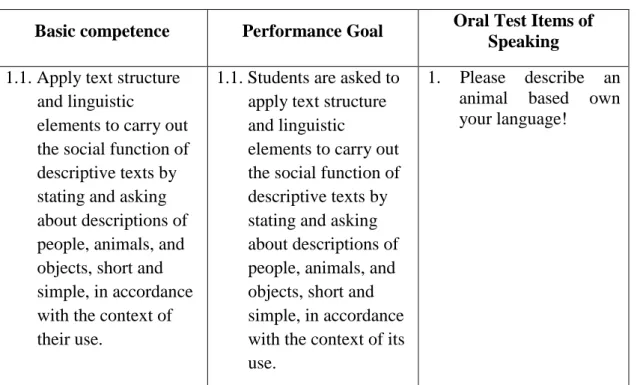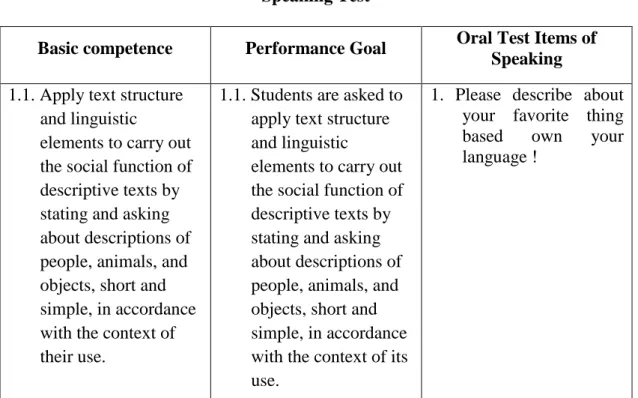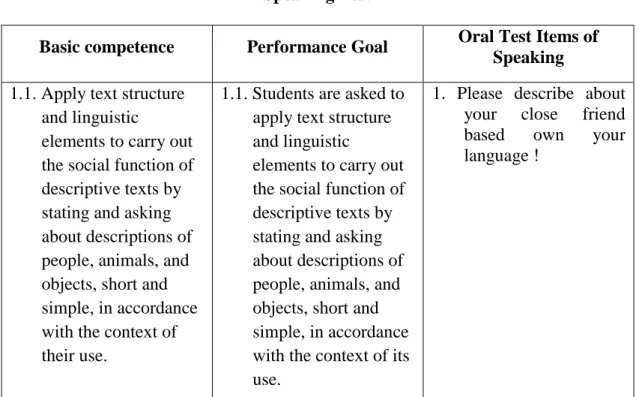This means that Community Circle Strategy can improve the students' speaking skills and learning activity under the eighth grade at SMP TMI Roudlotul Qur'an Metro. This undergraduate thesis is titled "Improving speaking skill using community circle strategy among the eighth grade students at SMP TMI Roudlotul Qur'an Metro".
INTRODUCTION INTRODUCTION
Identification of the Problems
Students think that speaking English is difficult, so most of them lack motivation to learn English.
Problem Limitation
Problem Formulation
Objective and Benefits of the Study 1. Objective of the Study
Prior Research
- Speaking Skill
- Community Circle Strategy
3 Leni Septianty, “Teaching Critical Thinking in Speaking by Combining an Academic Controversy Strategy with a Community Circle Strategy in Senior High School,” Pendidikan Bahasa Inggris Vol 1, no. In Speaking Combining Academic Controversy Strategy with Community Circle Strategy in Senior High School” Pendidikan Bahasa Inggris Vol.1, No.
Action Hyphotesis
- Variables of the research
A dependent variable is a variable that the researcher observes and measures to determine the effect of the independent variable. In this research, the researcher increased the number of students. speaking skill of eighth graders at SMP TMI Roudlotul Qur'an.
Setting of the Research
The community circle strategy is a learning strategy with a circular system where students share information simultaneously with different pairs in a short and orderly way. A topic can go around in circles many times before it is thoroughly discussed.
Subject of the Research
Action Plan
In this case, the researcher took steps from community circle strategy to improve students' speaking skill. The researcher prepared the lesson plan, procedure, media and relevant materials to apply in the scene phase. Furthermore, the researcher also collected the data of the post-test and result of student's activity.
In addition, the researcher also collected the post-test data and the result of the student's activity.
Data Collecting Technique
In this study the author observed the learning process of Class VIII of SMP TMI Roudlotul Qur'an in their classroom. In this research, the researcher used field notes to record the student's activity during the learning process and to get the complete data from the eighth grade students of SMP TMI Roudlotul Qur'an regarding the students' activities, the events in each step teaching, learning goals, learning. time and students' feelings in the learning process. To measure the speaking ability of the eighth grade students of SMP TMI Roudlotul Qur'an, the researcher applied the speaking test consisting of pre-test and post-test.
In this case, the researcher administered the speaking test in the form of an oral test.
Data Analysis
- Description of SMP TMI Roudlotul Qur’an Metro
- The Mission of the School
- Description of the Research
The number of students at SMP TMI Roudlotul Qur'an Metro in the academic year of. Source: Documentation of the number of students at SMP TMI Roudlotul Qur'an Metro in the academic year 2019/2020. Source: The grade result of SMP TMI Roudlotul Qur'an Metro pre-test speaking in VIII class on October 30, 2019.
Source: SMP TMI Roudlotul Qur'an Metro Class VIII Speaking Pre-Exam Score Result on October 30, 2019.
Acting
The researcher asked the students to think about what was being said in order to notice patterns after the students had finished discussing. The researcher asked the students to think about what was being said in order to notice patterns after the students had finished discussing the topic. The kind of test was a speaking test where the students were asked to describe a topic about describing.
The result of the students' test in post-test 1 was better than test in pre-test before.
Observing
Source: The grade result of speaking Post-test I at Class VIII of SMP TMI Roudlotul Qur'an Metro on November 8, 2019. The result of Post-test I showed that the proportion of students who did not achieve the minimum mastery criteria (MMC), is higher than the proportion of those who achieve the minimum mastery criteria (MMC). In addition, the results of the students' tests were better than the students' tests before they gave treatment.
Post-test 1
Students who were active in the discussion would get the point by marking it on the observation sheet for meeting 1 and meeting 2. Source: Student activity in the eighth grade of SMP TMI Roudlotul Qur'an Metro.
The Student's activity
Reflecting
From the result observation in the learning process in cycle I, it is concluded that the Minimum Mastery Criteria (MMC), which is 70 of the research, has not yet been achieved in the learning process. At the end of this cycle, the researcher analyzed and calculated all processes such as the students' pre-test grade and the result of the students' post-test I grade. The comparison of the percentage of the students' completeness grade on the pre- and post-test I.
Based on the table and the graph above, the result of the pre-test proved that 16 students (89%) were not successful and 2 other students.
Pre-test and post-test I
Planning
Based on the activities in cycle I, the process in cycle II focused on the problem of cycle I. Then, the researcher and the collaborator planned to give the students the material in speaking skill from film as a media. The researcher and the collaborator prepared the lesson plan, the observation sheet of the students' activities, identified the problem and found the causes of the problem in the first and last activities of the lesson.
Acting
The researcher began the lesson by praying, greeting, checking the attendance list and asking about the condition of the students. The researcher posted the topic of describing a person and asked the students to describe mother based on their own idea, one by one, taking turns in the circle. That kind of test was a speaking test that asked students to describe a close friend.
The results of the students' tests in posttest 2 were better than tests in posttest 1 before.
Observing
The result of Posttest II showed that the percentage of students' speaking skills achieved the indicator of success.
Post-test II
Source: Speaking skill of eighth grade students of Class VIII of SMP TMI Roudlotul Qur'an Metro. A high percentage of student activity was those who paid attention to the teacher's explanation 78%, then the students ask or answer the teacher's question 44% and are active in the lesson 83%, and the last one is able to do the task 61% and the last student who is was able to be active in a group activity 89%. Based on the above result, the researcher stated that the learning process in II. the cycle was successful because student activity reached a percentage of >70%.
Learning activities
Reflecting
From the result of the learning process in cycle II, the researcher analyzed that generally using the community circle strategy improved the students' speaking ability. At the end of this cycle, the researcher and the collaborator analyzed and calculated all the processes such as the II grade after the student's test and the observation of the students' learning activities. The comparison between students after class I test and after class II test can be compared in the table below.
Post-test I and Post-test II
INTERPRETATION
- Result of Students Learning a. Result of students Pre- Test Grade
- Comparison of Grade in Pre-Test, Post-Test I in cycle I, and Post-Test II in Cycle II
Comparison of grades in pre-test, post-test I in cycle I and post-test II in cycle II. Pre-Test, Post-Test I in Cycle I and Post-Test II in Cycle II No Names Pre-Test. Comparison of students' pre-test, class after test I in the first cycle and post-test of class II in the second cycle.
The comparative grade of students' speaking ability in pre-test, post-test I in cycle I and post-test II in cycle II.
Pre-Test, Post-Test I and Post-Test II
Result Observation of Students’ Activity
Based on the data obtained, it could be concluded that the total number of students in cycle I who paid attention to the teacher's explanation was 13 (72%), students were very active in asking or answering the question, it was only six students (33%). From the above result, the researcher concluded that this study was successful and would not be continued to the next cycle.
DISCUSSION
Based on the result of the learning process in two cycles, the researcher wants to describe the conclusion that speaking skill can be improved through Community Circle strategy in the eighth grade of SMP TMI Roudlotul Qur'an Metro, Community Circle Strategy can be improved among the eighth grader at SMP TMI Roudlotul Qur'an Metro. The percentage of students' speaking ability obtained from the Post-test II of cycle II is 77%. It means that the result of cycle II had already reached the success indicator which is 70% of students reaching the minimum mastery criteria (MMC).
In addition, the implementation of the Community Circle strategy can improve the learning activity of the eighth grade students of S&P TMI Roudlotul Qur'an Metro.
Suggestion
Junita, Syafrina."Teaching Speaking By Combining Photo Analysis And Community Circle Strategies At Junior High School Students", Pendidikan Bahasa Inggris Vol 1, No. Leni Septanty,"Teaching Critical Thinking in Speaking by Combining Academic Controversy Strategy with Community Circle Strategy at Senior High School”, Pendidikan Bahasa Inggris Vol 1, No. Nurhanifa,”Teaching Speaking by Combining Community Circle Strategy with 20 Questions Strategy at Junior High School”, Pandidikan Bahasa Inggris Vol 4, No.
Septianty, Leni, "Teaching critical thinking in speaking by combining academic controversy strategy with community circle strategy in high school" Pendidikan Bahasa Inggris Vol 1, No.
APPENDICES
Langkah-Langkah Kegiatan Pembelajaran
Siswa menyimak dan menirukan beberapa kalimat yang menunjukkan dan menanyakan letak orang, benda dan hewan pada bilangan tak tentu, yang dicontohkan dan dibacakan oleh guru sesuai dengan konteks penggunaannya. Dengan bimbingan dan arahan guru, siswa mengidentifikasi ciri-ciri kalimat yang menunjukkan dan menanyakan tentang letak orang, benda, dan hewan dalam bilangan tak tertentu (fungsi sosial, struktur teks, dan unsur kebahasaan). Dengan bimbingan dan arahan guru, siswa mempertanyakan perbedaan berbagai kalimat yang menunjukkan dan menanyakan keberadaan orang, benda, dan hewan dengan cara yang tidak ditentukan.
Siswa membaca contoh kalimat lain yang menunjukkan dan menanyakan letak orang, benda, dan hewan dalam bilangan tak tentu dari sumber lain.
Rubik Penilaian
- Penilaian Dari Aspek Pengetahuan (Knowledge) Format Penilaian Individu
5 = Siswa selalu menunjukkan rasa hormat 4 = Siswa menunjukkan rasa tidak hormat 3 = Siswa beberapa kali menunjukkan rasa tidak hormat 2 = Siswa sering menunjukkan rasa tidak hormat. 5 = Siswa selalu menunjukkan sikap peduli 4 = Siswa pernah menunjukkan sikap acuh tak acuh 3 = Siswa sudah beberapa kali menunjukkan sikap acuh tak acuh 2 = Siswa sering menunjukkan sikap acuh tak acuh. 5 = Siswa selalu menunjukkan sikap berani 4 = Siswa tidak pernah menunjukkan sikap berani 3 = Siswa beberapa kali menunjukkan sikap berani 2 = Siswa sering menunjukkan sikap berani.
5 = Siswa selalu menunjukkan kepercayaan diri 4 = Siswa menunjukkan ketidakpastian 3 = Siswa menunjukkan ketidakpastian beberapa kali. 2 = Siswa sering menunjukkan sikap tidak pasti 1 = Siswa sangat sering menunjukkan sikap tidak pasti e. 5 = Siswa selalu menunjukkan sikap ingin tahu 4 = Siswa menunjukkan sikap tidak ingin tahu 3 = Siswa sering menunjukkan sikap tidak ingin tahu 2 = Siswa sering menunjukkan sikap tidak ingin tahu.


